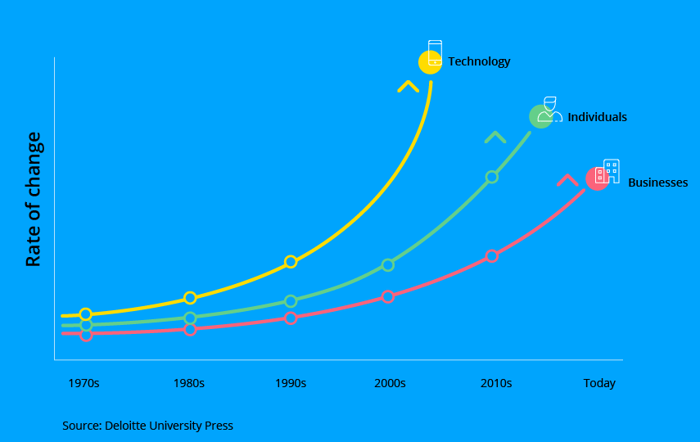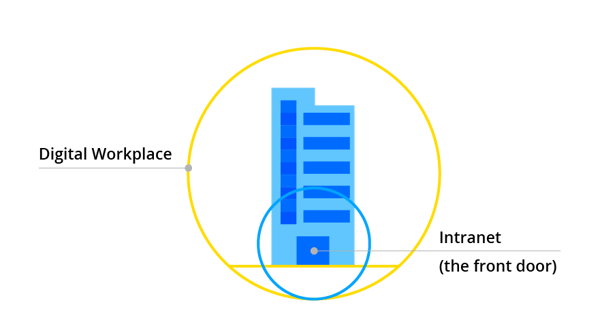8 Reasons Why Internal Communication Is Even More Important in 2018
Written by Robert Grover, Staffbase.com.
Each new year sees the publication of countless lists and blogs featuring instructions and magic formulas which business communicators are implored to adopt lest they lose the ear of their internal audience. But commonsense advice doesn’t change with the calendar. When it comes to internal communication in today’s workplace, what was important last year remains so today and will continue to be imperative into the foreseeable future. That’s why some of the information you’ll find in this piece might look familiar from last year’s popular blogpost on the subject. The goal of IC remains as always: the effective and timely dissemination of crucial information to the most relevant audience within an organization. What’s changing is the number of tools on the market for achieving this goal.
That said, there’s an interesting point to be made about the proliferation of enterprise communication platforms. As Alan Lepofsky, principal analyst at Constellation Research says, “Email, chat, blogs, wikis, social networks, and iterative group chats like Slack. We’ve gone far more mobile than we ever were and far more cloud than before. But these haven’t fundamentally changed the way we discover, create, and share ideas.”
That’s why the number one priority of internal communications in 2018 is not only to invest in tools such as enterprise social networks and company apps—which rate first and second among the channels on which organizations are most likely to spend—but to identify the specific challenges of your particular workplace. Doing so will allow you to make the most sensible platform decisions and to develop strategies for putting them to their greatest use.

How can businesses and individuals keep up with the exponential rate of technological change?
1. Communication Needs to Be Faster Than the Accelerating Pace of Change
“It is not the strongest of the species that survives, nor the most intelligent . . . It is the one that is the most adaptable to change.”
—Charles Darwin
As technology continues to evolve at an ever-quickening pace, with deep implications that impact every aspect of our lives, managing change has become a key source of corporate competitiveness. Of course, not everyone likes change, and in the business world, dealing with resistance to it generally falls to a company’s internal communications systems and processes. This is clearly a problem if your organization fails to recognize how internal communication sets the standard for how you want your employees to interact with one another and the customers they serve.

Don’t be a communications dodo.
Communication defines workplace culture, which is ultimately reflected in your brand. And it plays a key role in the nurturing and retention of top talent. Weekly newsletters and emails are no longer effective ways for getting your message across. It is ever more essential that your internal channels be immediate, targeted, measurable—and mobile. Most importantly, they must be faster than the speed of change. While you might not always make people 100% comfortable with change, you will be able to minimize their discomfort.
The first step in figuring out how to manage change is to understand why people are resisting it. Tools that facilitate the gathering of feedback from resistors will improve the process that ultimately leads to acceptance.
2. Workplace Generation Gaps Shouldn’t Be Communication Gaps

At the beginning of 2017, we talked about how millennials had overtaken baby boomers to become the largest sector of the workforce and had begun moving into management positions. We also pointed out that members of Generation Z were starting to take their first full-time jobs. What this means, we argued, is that creating an engaging workplace for multigenerational employees requires strategies for addressing a wide range of sometimes conflicting values and communication styles.
This requirement is still very much the case in 2018, but while we previously wrote specifically about engaging Gen Z and millennials, we didn’t mention older workers—with unique workplace expectations and ways of communicating that are just as important to address as those of their younger colleagues. Effective communication with older employees takes on added significance when considering that workers who are at or approaching the traditional retirement age of 65 are currently the fastest-growing segment of the US workforce.
A recent survey by the Society for Human Resource Management, conducted in partnership with the AARP, found that nearly half of all employers think the loss of older workers over the coming decade will be a problem. To address it, many companies have begun instituting mentorship programs that encourage younger employees to learn from their older peers. Research also suggests that putting old and young workers together boosts the performance of both groups. Their matching interests—which include work being a source of social interaction—make them good allies, and because they’re at different life stages, they tend to work well together and be less competitive with one another.
A further benefit of the older generation is their relatively stable work habits compared to millennials, more than 90% of whom expect jobs to last less than three years. Such mercenary attitudes make long-term employees even more valuable. Try to find ways to communicate and embrace the beneficial relationships that can be fostered between workers of all ages.
3. Trickle-Down Communication Is a Failure
Most companies cascade information top-down through their hierarchies. The resulting trickle of information often leads to delays, limited feedback, and a dependence upon the efforts of individuals along the chain of communication.
Plenty of information is going out—the problem is that most of it isn’t reaching the people who need it most—i.e., the ones actually doing the work. Putting responsibility for internal communication into the hands of employees at every level of your organization can make this chain much more effective. Providing middle management in particular with robust and mobile communication tools will enable them to be better leaders.
Dispersed, two-way internal communication presents a valuable opportunity for companies to better understand their workforce, ultimately leading to better-informed managers and more effective management decisions.
4. Employees Are Seeking Purpose
“73% of employees who say they work at a “purpose-driven” company are engaged with the jobs they do, compared to just 23% of those who say they don’t.” Additionally, a global survey of 26,000 LinkedIn members, taken by the research firm Imperative, found that 73% of its participants want a career in which they feel that their job matters. Today’s employees, no matter their age, demand that their goals be clearly defined; they need to understand the plans for attaining these goals; and to be confident about the value of thei individual contributions. They want to feel useful, that their opinions matter, and that they’re part of a team. This is especially true for millennials and Gen Z, who rely heavily on feedback and interaction. Having grown up in the age of social media, they’re used to a constant flow of likes, sharing, and comments, and are motivated by such assessments.
Helping employees find purpose can be as simple as broadcasting their accomplishments. For example, it’s highly effective and encouraging to regularly post and share information about what a team or company has achieved. A sense of attaining goals together increases feelings of teamwork and progress.
A well-functioning internal communications system can motivate employees to work toward a common goal. By illuminating the reasons behind what they’re being asked to do, companies can inspire workforces to go the extra mile.
5. Outside Noise Is Overpowering Your IC
In an age when information is accessible on our smartphones and other mobile channels 24/7, shutting out the noise can be a challenge. But as difficult as it might be to prevent, employees should never learn about important company news from extenal sources. Many organizations are intimidated by the threat of outside influence on their internal communication. That said, the only way to deal with it is by learning to make their point of view readily available at a moment’s notice—whether company-wide or to a targeted audience—and not just during times of crisis, but in your day-to-day operations.
Two main requirements are necessary to ensure that information comes from the right source, is timely, and reaches all employees: First, you need a well-defined, fast, and flexible editing process with a short approval chain. Designing such a structure is similar to the challenge companies faced when first forced to define processes for responding to crises sparked on social media channels, something they needed to do within minutes—not days.
Secondly, organizations need to establish a fast, interactive, and reliable channel for reaching all of their employees. “Fast” and “interactive” means digital—and these days, digital means mobile. As in many other use cases, a combination of new procedures, skills, and technologies are needed to create trust and transparency, enabling companies to retain control of their message and not leave information susceptible to misinterpretation and rumor, with internal turmoil often the result.
6. Customers Expect You to Keep Your Brand Promises
Your customers expect your brand to consistently deliver on its promises. This is true both for consumers and B2B customers. But how can companies make sure this works in a large distributed organization with hundreds or even thousands of middle managers? The only way is via effective internal communications with their frontline employees.
Clearly-communicated goals, well-trained and informed staff, and contented faces will significantly improve customers’ encounters with your brand and consequently enhance revenue.
“Customer experience is the most pressing mandate for marketers, the top area of marketing technology investment in 2016, and it will lead innovation spending for 2017.” A Gartner survey found that 89% of companies expect to compete mostly on the basis of customer experience, versus 36% only five years ago. In addition, 50% of consumer product investments are now directed to customer experience innovations.
What’s clear is that great brands are built from the inside out. Start with your employees, and their satisfaction will be projected directly to your customers.
7. Informal Communication Can Distort Information
Informal communication has its advantages and disadvantages. Grapevine word-of-mouth can sometimes help employees to interpret managerial information; it often reaches workers who might have otherwise missed the original transmission; and it’s more flexible than formal communication. The grapevine also helps to improve relationships between employees and it spreads knowledge and tips that can make work more effective.
On the other hand, informal communication can distort the meaning of information; it feeds rumors and misunderstandings; and it’s difficult to control.
Good internal communication can help to increase the advantages of informal communication. It will slow down the rumor mill by communicating quickly and frequently, and it will help employees to clearly interpret information and instructions.
Employees put a premium on transparency in their interactions with different levels of management, going so far as to name it the top factor in determining their happiness and satisfaction in the workplace. Providing a transparent, rumor-free environment is a must for a generation of employees (and customers) who are skeptical to the core.
8. Intranets Continue to Evolve
As digital workplaces gain traction, the question often arises as to whether intranets are still even necessary. While we believe that the role and shape of intranets needs to undergo substantial changes, the concept itself is still an important part of the digital workplace.
The greatest potential of the evolving intranet is to provide a front door through which an employee can find the various tools and services of the digital workplace. This front door needs to be easily accessible on all devices; to be truly effective it should be branded and personalized; and it should be able to act as an employee’s primary communication hub.

A tool like an employee app can play all of these roles—it can be mobile but it can also work on desktop. Such a platform can be a great front door to an Office 365 environment, for example, with tools like SharePoint, Yammer, or Teams.
Why It’s Imperative to Improve Your IC Right Now
The touchpoints that employees have with their workplaces play a vital role in how they stay motivated, informed, and engaged with what they do. Just as technology has become a crucial part of our personal lives, the tech environment in the workplace is of great importance to the employee experience. In this transformative era of hyper-modern organizations, competitiveness depends upon the ability to manage change. Especially for businesses with large, widely distributed workforces, keeping pace with rapid innovation requires modern tools that can effectively keep all employees fully informed.
These needs, combined with increased demands for better work/life balance, flexible hours, and the ability to work from multiple locations, means that companies must provide their employees—including offline, frontline, and non-desk workers—with an employee experience that is mobile. Enabling your workforce to engage with co-workers and information wherever they are and whenever they choose is a difference-maker in the increasingly competitive market for attracting talent and creating the positive workplace environment necessary for businesses to thrive.
“If everyone is moving forward together, then success takes care of itself.”
—Henry Ford
Effective internal communication is a powerful force that helps enrich employees’ lives and leads to a 40% increase in customer satisfaction, a 30% increase in profitability, and a 36% increase in the overall performance of the company. Providing the whole of your organization with effective tools for communicating with one another is a key business function that will inspire and align everyone.
[Original post: 8 Reasons Why Internal Communication Is Even More Important in 2018]
Want to learn more? Attend the 5th Annual Strategic Internal Communications conference in Boston on July 17 – 19, 2018.
Comments are closed.